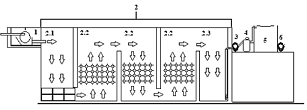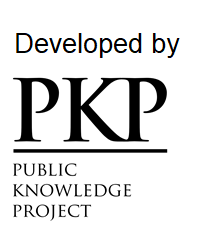Recirculating aquaculture systems affects hematological parameters and increases ectoparasite susceptibility in Nile tilapia Oreochromis niloticus
DOI:
https://doi.org/10.47193/mafis.3742024010708Keywords:
Intensive fish farm, blood count, MonogeneaAbstract
We herein evaluated the hematology and parasitology of Nile tilapia previously raised in an earthen pond and transferred to a recirculating aquaculture system (RAS) to verify any possible influence of RAS on such health parameters. For this, 780 tilapias with an initial average weight and length of 91.05 ± 27.08 g and 17.45 ± 1.91 cm, respectively, were distributed in three tanks (2.0 m3) attached to the RAS, where they remained for 54 d. Throughout the period, water quality parameters remained within the range suitable for the cultivation of the species. Tilapia growth performance was satisfactory in the RAS, reaching a final biomass of close to 300 kg and survival of 98%. Hematological and parasitological analyses at the end of 54 d showed possible stress in RAS, with a significant increase in neutrophils from 12.15 ± 6.66 (earthen pond) to 21.43 ± 11.68% (RAS) and erythrocytes from 1.81 ± 0.24 (earthen pond) to 2.13 ± 0.14 (RAS), and a significant decrease in lymphocytes from 22.4 ± 2.66 (earthen pond) to 13.67 ± 3.38 (RAS). Furthermore, parasitological analysis showed a significant increase in the number of parasitized fish (25% to 63%) and abundance (3.55 ± 6.44 to 9.37 ± 9.99) after 54 d. It was concluded that tilapia cultivation in RAS can cause hematological changes and increase parasitism.
Downloads
References
Arana LV. 2010. Qualidade da água em aquicultura princípios químicos e práticos. 3rd ed. Florianópolis: Editora da Universidade Federal de Santa Catrina. 161 p.
Bendschneider K, Robinson RJA. 1952. New spectrophotometric method for the determination of nitrite in sea water. J Mar Res. 11: 87-96.
Bush AO, Lafferty KD, Lotz JM, Shostak AW. 1997. Parasitology meets ecology on its own terms: Margolis et al. revisited. J Parasitol. 83 (4): 575-583. DOI: https://doi.org/10.2307/3284227
Dara M, Carbonara P, La Corte C, Parrinello D, Cammarata M, Parisi MG. 2023. Fish welfare in aquaculture: physiological and immunological activities for diets, social and spatial stress on Mediterranean aqua cultured species. Fishes. 8 (8): 414. DOI: https://doi.org/10.3390/fishes8080414
Eaton AD, Clesceri LS, Rice EW, Greenberg AE. 2005. Standard methods for the examination of water and wastewater. 21st ed. Washington: American Public Health Association.
Ebeling JM, Timmons MB. 2012. Recirculating aquaculture systems. In: Tidwell JH, editor. Aquaculture production systems. Wiley-Blackwell. p. 245-277. DOI: https://doi.org/10.1002/9781118250105.ch11
[FAO] Food and Agriculture Organization of the United Nations. 2022. The State of world fisheries and aquaculture 2022. Towards blue transformation. Rome: FAO. 266 p. DOI: https://doi.org/10.4060/cc0461en
Fazio F. 2019. Fish hematology analysis as an important tool of aquaculture: a review. Aquaculture. 500: 237-242. DOI: https://doi.org/10.1016/j.aquaculture.2018.10.030
Fujimoto RY, Santana CA, De Carvalho WLC, Diniz DG, De Barros ZMN, Varella JDA, Guimaraes MDF. 2009. Hematologia e parasitas metazoários de camurim (Centropomus undecimalis, Bloch, 1792) na região bragantina, Bragança-Pará. Bol Inst Pesca. 35 (3): 441-450. https://institutodepesca.org/index.php/bip/article/view/872/854.
Geletu TT, Zhao J. 2023. Genetic resources of Nile tilapia (Oreochromis niloticus Linnaeus, 1758) in its native range and aquaculture. Hydrobiologia. 850 (10-11): 2425-2445. DOI: https://doi.org/10.1007/s10750-022-04989-4
Goldenfarb PB, Bowyer FP, Hall E, Brosius E. 1971. Reproducibility in the hematology laboratory: the microhematocrit determination. Am J Clin Pathol. 56 (1): 35-39. DOI: https://doi.org/10.1093/ajcp/56.1.35
Golterman HL, Clymo RS, Ohnstad MAM. 1978. Methods for physical and chemical analysis of freshwaters. Scientific Publications. IBP Handbook. 8. Oxford: Blackwell. 213 p.
Ishikawa NM, Ranzani-Paiva MJT, Lombardi JV. 2008. Metodologia para quantificação de leucócitos totais em peixe, Oreochromis niloticus. Arch Vet Sci. 13: 54-63.
Jerônimo GT, Speck GM, Cechinel MM, Gonçalves ELT, Martins ML. 2011. Seasonal variation on the ectoparasitic communities of Nile tilapia cultured in three regions in southern Brazil. Braz J Biol. 71: 365-373. DOI: https://doi.org/10.1590/S1519-69842011000300005
Koroleff F. 1976. Determination of ammonia. In: Grasshoff K, editor. Methods of seawater analysis. Weinheim: Verlag Chemie. p. 126-133.
Lacerda ACF, Roumbedakis K, Junior JB, Nuñer APO, Petrucio MM, Martins ML. 2018. Fish parasites as indicators of organic pollution in southern Brazil. J Helminthol. 92 (3): 322-331. DOI: https://doi.org/10.1017/S0022149X17000414
Marengoni NG. 2006. Produção de tilápia do Nilo Oreochromis niloticus (linhagem chitralada), cultivada em tanques-rede, sob diferentes densidades de estocagem. Arch Zoot. 55 (210): 127-138. https://www.redalyc.org/pdf/495/49521001.pdf.
Mengistu SB, Mulder HA, Benzie JA, Komen H. 2020. A systematic literature review of the major factors causing yield gap by affecting growth, feed conversion ratio and survival in Nile tilapia (Oreochromis niloticus). Rev Aquacult. 12 (2): 524-541. DOI: https://doi.org/10.1111/raq.12331
Moraes AV, Owatari MS, Da Silva E, De Oliveira Pereira M, Piola M, Ramos C, Farias DR, Schleder DD, Jesus GFA, Jatobá A. 2022. Effects of microencapsulated probiotics-supplemented diet on growth, non-specific immunity, intestinal health and resistance of juvenile Nile tilapia challenged with Aeromonas hydrophila. Anim Feed Sci Technol. 287: 115286. DOI: https://doi.org/10.1016/j.anifeedsci.2022.115286
Noga EJ. 2010. Fish disease: diagnosis and treatment. 2nd ed. Wiley-Blackwell. 536 p.
Owatari MS, Da Silva LR, Ferreira GB, Rodhermel JCB, De Andrade JIA, Dartora A, Jatobá A. 2022b. Body yield, growth performance, and haematological evaluation of Nile tilapia fed a diet supplemented with Saccharomyces cerevisiae. Anim Feed Sci Technol. 293: 115453. DOI: https://doi.org/10.1016/j.anifeedsci.2022.115453
Owatari MS, Jesus GFA, Cardoso L, Lehmann NB, Martins ML, Mouriño JLP. 2020. Can histology and haematology explain inapparent Streptococcus agalactiae infections and asymptomatic mortalities on Nile tilapia farms? Res Vet Sci. 129: 13-20. DOI: https://doi.org/10.1016/j.rvsc.2019.12.018
Owatari MS, Magnotti C, Mattos DDC, Mendonça RC, Castilho-Barros L, Sterzelecki FC. 2022a. Sistemas de recirculação e reúso de água na aquicultura: uma ferramenta para sustentabilidade. In: Barbosa FC, editor. Ciências agrárias: a multidisciplinaridade dos recursos naturais. 10th ed. Piracanjuba: Editora Conhecimento Livre. p. 65-90. DOI: https://doi.org/10.37423/221206928
[PeixeBR] Brazilian Association of Pisciculture. 2023. Brazilian pisciculture yearbook. edition 2023. São Paulo: PeixeBR. 65 p. [accessed 25 Nov 2023]. https://www.peixebr.com.br/anuario/.
Ranzani-Paiva MTJ, Silva-Souza AT. 2004. Hematologia de peixes brasileiros. In: Ranzani Paiva MTJ, Takemoto RM, Perez Lizama MLA, editors. Sanidade de organismos aquáticos. São Paulo: Editora Varela. p. 89-120.
Rosenfeld G. 1947. Corante pancrômico para hematologia e citologia clínica. Nova combinação dos componentes do may-grunwald e do giemsa num só corante de emprego rápido. Mem Inst Butantan. 20: 329-335.
Roveda M, De Menezes CCA, Bolívar-Ramírez NC, Owatari MS, Jatobá A. 2024. Acidifying remediation and microbial bioremediation decrease ammoniacal nitrogen, orthophosphates, and total suspended solids levels in intensive Nile tilapia farming under biofloc conditions. Aquaculture. 580: 740292. DOI: https://doi.org/10.1016/j.aquaculture.2023.740292
Sampaio JMC, Braga LGT. 2005. Cultivo de tilápia em tanques-rede na barragem do Ribeirão de Saloméa-Floresta Azul-Bahia. Rev Bras Saúde Prod An. 6 (2): 42-52. http://www.uesc.br/laboratorios/aquanut/635-2462-2-PB.pdf.
Tavares-Dias M, Faustino CD. 1998. Parâmetros hematológicos da tilápia-do-Nilo Oreochromis niloticus (Cichlidae) em cultivo extensivo. Ars Vet. 14 (3): 254-263.
Tavares-Dias M, Ishikawa MM, Martins ML, Satake F, Hisano H, Pádua SBD, Jerônimo GT, Sá ARSD. 2009. Hematologia, ferramenta para o monitoramento do estado de saúde de peixes em cultivo. In: Saran Neto A, Mariano WDS, Sória SFP, editors. Tópicos especiais em saúde e criação animal. São Carlos: Pedro & João Editores. p. 43-80.
Tavares-Dias M, Martins ML. 2017. An overall estimation of losses caused by diseases in the Brazilian fish farms. J Parasit Dis. 41: 913-918. DOI: https://doi.org/10.1007/s12639-017-0938-y
Timmons MB, Embeling JM. 2010. Recirculating Aquaculture System. 2nd ed. Ithaca: Editora Cayuga Aqua Ventures. 948 p.
Valenti WC, Barros HP, Moraes-Valenti P, Bueno GW, Cavalli RO. 2021. Aquaculture in Brazil: past, present and future. Aquacult Rep. 19: 100611. DOI: https://doi.org/10.1016/j.aqrep.2021.100611
Zhang XP, Li WX, Ai TS, Zou H, Wu SG, Wang GT. 2014. The efficacy of four common anthelmintic drugs and traditional Chinese medicinal plant extracts to control Dactylogyrus vastator (Monogenea). Aquaculture. 420: 302-307. DOI: https://doi.org/10.1016/j.aquaculture.2013.09.022
Zar JH. 2009. Biostatistical analysis. 4th ed. New Delhi: Pearson Education. 662 p.

Published
Issue
Section
License
Copyright (c) 2024 Rodrigo Stallbohm, Marco Shizuo Owatari, Evoy Zaniboni-Filho, Maurício Laterça Martins

This work is licensed under a Creative Commons Attribution-NonCommercial-ShareAlike 4.0 International License.
Authors of articles published in Marine and Fishery Sciences retain copyright on their articles, except for any third-party images and other materials added by Marine and Fishery Sciences, which are subject to copyright of their respective owners. Authors are therefore free to disseminate and re-publish their articles, subject to any requirements of third-party copyright owners and subject to the original publication being fully cited. Visitors may also download and forward articles subject to the citation requirements. The ability to copy, download, forward or otherwise distribute any materials is always subject to any copyright notices displayed. Copyright notices must be displayed prominently and may not be obliterated, deleted or hidden, totally or partially.
This journal offers authors an Open Access policy. Users are allowed to read, download, copy, distribute, print, search, or link to the full texts of the articles, or use them for any other legal purpose within the Creative Commons 4.0 license (BY-NC-SA), without asking prior permission from the publisher or the author. This is in accordance with the BOAI definition of Open Access.





























